Archive : 30 October 2008 year
Autoliv Selects Infineon Automotive Power Semiconductors for Innovative Seatbelt Pretension Systems
21:21Autoliv Inc. and Infineon Technologies AG today announced that Autoliv has selected Infineon as sole supplier of power semiconductors for its next-generation seatbelt pretension systems, called Active Seatbelts. The Infineon power chip, capable of controlling an electrical motor with a relatively high current for a very short period of time, is a member of the NovalithIC™ family recently launched in volume quantities. Autoliv, the world’s largest automotive safety system supplier, uses an electrical motor and electronics to improve occupant safety by starting to tighten the seatbelt a few milliseconds before an imminent crash. Infineon’s chip has a crucial role in controlling and powering the electrical motor. Autoliv is ramping up production of these active seatbelt systems which are currently used in premium cars.
Innovative Active Seatbelts for added safety and comfort in cars
Autoliv’s Active Seatbelts use a small motor device containing the Infineon NovalithIC power chip, which enables additional safety and comfort features in cars. For instance, if a collision is anticipated, an occupant’s seatbelt will be automatically tightened to remove any existing belt slack before a collision, thereby reducing the risk for rib fractures and other injuries. Autoliv’s innovative seatbelt pretension system has the capability to adapt the restraint force to the severity of the crash and weight of the occupant. The seatbelt pretensioners also facilitate buckling up and improve comfort by softly tightening the seatbelt when buckling up. Finally, unlike regular pyrotechnic seatbelt pretensioners, Active Seatbelts can be tightened to minimize the G-forces when driving through curves.
“The combination of our many years of experience in innovative safety systems and Infineon’s expertise in semiconductors has resulted in this new approach for Active Seatbelt pretension systems,” said Steve Rode, President of Autoliv Electronics. “We selected Infineon, which has been a supplier to us for many years, because of Infineon’s continuous focus on high quality level automotive solutions.”
“Automotive safety electronics is a key area for Infineon. Our automotive chips support the European Union’s goals to cut the number of traffic accidents in half by 2010. It is Infineon’s objective to provide more intelligent automotive chips to help make cars safer, more convenient and more energy efficient,” said Claus Geisler, Senior Vice President and General Manager at the Automotive division of Infineon Technologies. “Our NovalithICs combine our core competencies in automotive power chip technologies with the latest advanced assembly technologies using chip-on-chip and chip-by-chip schemes.”
Up to 70 small motors in a car using power chips
On average, a mid-range car today contains about 40 to 50 small motors used to change the position of various features in the car including a driver’s wheel, seats, window-lifts and sun roof. In the premium car segment, there are about 70 motors per car. According to the May 2008 report of the market research company Strategy Analytics, Infineon is the world’s second largest and Europe’s largest provider of automotive semiconductors with a global market share of 9.4 percent of the total USD 19.3 billion automotive semiconductor market in the 2007 calendar year. Autoliv accounts for more than a third of the global seatbelt market. Last year, the company sold more than 110 million seatbelt systems. Almost half of them had regular non-reversible pyrotechnic pretensioners that tighten the belt at the onset of a crash.
Technical information on NovalithIC
The NovalithIC combines three integrated circuits - two power chips and one logic circuit to control and monitor the power stage – in one small package of approximately 1 square centimeter in size, using the latest chip-by-chip as well as chip-on-chip technologies. The NovalithIC family provides a fully integrated high current half-bridge for motor drive applications. The devices cut by half the space needed on a printed circuit board for power electronics driving motor applications with industry leading currents of up to 70 Ampere (A). Power output varies continuously depending on application need – a feature that slashes energy consumption by as much as 80 percent. As the on-state resistance is typically just 16 mOhm and the quiescent current just 7 µA the device is very energy efficient. Available in lead-free (green) packages, NovalithICs serve a broad range of applications, from smaller motors such as fuel pumps and windshield wiper drives in automobiles to more power-hungry equipment such as drills, air-conditioning systems and engine cooling fans. The NovalithICs in Autoliv's Active Seatbelts are lead-free.
Cirrus Logic’s CS8422 Digital Audio Receiver IC with Integrated Sample-Rate Converter Technology Provides Category’s Best Jitter Rejection for Consumer, Pro Audio Applications
21:15Cirrus Logic Inc. has introduced the CS8422, a 24-bit, 192 kHz digital audio receiver with a low-jitter PLL and integrated asynchronous sample rate converter. The CS8422 gives designers of consumer and professional audio applications a top-value solution for receiving a variety of incoming digital audio sources – such as from set top boxes, Blu-ray® Disc players and game consoles – and ensures audio quality is maintained throughout the entire signal processing chain from digital audio input to analog output.
The digital audio receiver utilizes a high performance PLL, which does not require any external loop filter components, for ultra-low jitter clock recovery and high jitter rejection from incoming audio streams. The CS8422 integrates an input multiplexer that supports up to four S/PDIF or two differential AES3 audio inputs, receiver to transmitter pass-through and TDM mode for automotive applications.
“The CS8422 was designed to lock to any digital audio source, good quality or bad, and the performance of the PLL makes that possible,” said Carl Alberty, director of Marketing, Mixed Signal Audio Division, Cirrus Logic. “The integrated sample rate converter simplifies designs and ensures the audio quality of the signal is not compromised.”
Digital audio can be routed from the receiver output or a standard serial audio port into the stereo asynchronous sample rate converter. The sample rate converter removes the requirement for designs to vary system clocking to support digital audio sources of different sample rates. Supporting input/output rations from 6:1 and 1:6, the CS8422 provides transparent conversion with 140dB dynamic range and -120dB THD+N performance. The CS8422 combines the ideal performance and cost for audio applications such as home theater systems, televisions, media centers, mixing consoles and effects processors, multitrack recorders and PC soundcards.
The CS8422 is offered in a 32-lead QFN package and operates from a single, 3.3V supply with on-chip level shifters to support a direct interface to logic levels from 1.8V to 5V. Audio data is input through the digital interface receiver or a three-wire serial audio input port, with audio output through one of two three-wire serial output ports. Its phase-lock loop core provides high tolerance to input jitter, and can output 192Fs, 384Fs, 512Fs, 768Fs, or 1024Fs recovered output clock rates.
Pricing and Availability
The CS8422, which is in volume production, is available in a 32-pin QFN package and is priced at $3.84 in quantities of 10,000.
From: http://cirrus.com
Ultra Small Cirrus Logic Portable Audio Codec With Class H Technology Improves Battery Life Up to Two Hours
21:13Manufacturers of portable devices such as media players, navigation devices, wireless headsets, voice recorders and gaming products now have access to Cirrus Logic Inc.’s (Nasdaq: CRUS) flagship portable audio codec, the CS42L55.
Consuming only 5.1 mW quiescent power in playback mode and featuring a unique bimodal, patent-pending Class H technology, the 24-bit CS42L55 reduces power consumption by nearly 50 percent compared to Class A/B amplification found in portable applications today. This innovation helps to increase battery life operating at standard audio sample rates and delivering power into headphones in real-world audio playback conditions by as much as two additional hours while maintaining high audio quality. The CS42L55 features an ultra small 5x5 mm footprint, and at 0.45 millimeters in height, it is one of the thinnest portable audio codec available today.
“No other portable audio codec in production offers the combination of performance, feature integration, battery life and overall small size like the CS42L55,” said Jason Rhode, president and chief executive officer, Cirrus Logic. “This IC is a prime example of why Cirrus Logic has become the new technology innovator in low-power audio products. We continue to take significant market share in portable audio products as customers value the innovation that we provide.”
The CS42L55 features automatic, supply-adjusting bimodal Class H headphone driver technology and an innovative charge pump architecture with ground-centered outputs. These technologies have become the innovative foundation for Cirrus’ line of portable audio products and allow its codecs to achieve ultra low power consumption and EMI performance well below industry requirements.
Based on 24-bit advanced multibit Delta-Sigma technology, the CS42L55 operates from a single 1.8 V or 2.5 V power supply and can deliver 1 VRMS line output from a 1.8 V supply. When driving headphones from the same supply it can deliver 17 milliwatts per channel of high-quality, 96 dB dynamic range audio. The CS42L55 also provides a 2:1 stereo input multiplexer and a USB master clock input and supports sample rates up to 48 kHz. The CS42L55 also features analog volume control that helps to increase performance and reduce the overall noise floor. Further, pseudo differential outputs allow for routing signals while reducing noise coupling in analog signals.
Pricing and Availability
The CS42L55 is available today in a 36-pin xQFN package, priced at $1.73 in quantities of 10,000.
From: http://cirrus.com
Frequency Synthesizer with Intelligent Dynamic Switching Provides Sub-Picosecond Jitter for High-End Servers
21:09Maxim Integrated Products (NASDAQ: MXIM) introduces the MAX3678 low-jitter frequency synthesizer with nine LVPECL clock outputs and intelligent dynamic switching. This device generates up to a 333MHz clock output from a low, 66.6MHz reference clock input. It utilizes low-noise VCO and PLL architecture to ensure low 0.30psRMS jitter (12kHz to 20MHz) with -60dBc power-supply noise rejection. The MAX3678 thus eases system-timing design and increases reliability, making it ideal for high-speed synchronized applications such as high-end server memory and CPU clock generation.
Configured through its pins or I²C interface, the MAX3678 generates two different frequencies to provide both a memory-module reference clock and a CPU clock. This feature eliminates the need for an expensive high-frequency oscillator, as well as a fanout buffer, thus saving board space and overall BOM.

The MAX3678 is fully specified over the 0°C to +85°C extended temperature range, and operates from 3.3V ±5%. It is available in a lead-free, 56-pin TQFN package. Prices start at $16.00 (1000-up, FOB USA). An evaluation kit is available to speed design.
Maxim Integrated Products is a publicly traded company that designs, manufactures, and sells over $2 billion of high-performance semiconductor products annually. It was founded over 25 years ago with the mission to deliver innovative analog and mixed-signal engineering solutions that add value to its customers' products. To date, Maxim has developed over 5800 products serving the industrial, communications, consumer, and computing markets. For more information, go to www.maxim-ic.com.
LTC2261: 14-Bit 125Msps ADC Dissipates One-Third the Power of Existing Solutions without Sacrificing AC Performance
21:07Linear Technology introduces a low-power 14-bit, 125Msps ADC that dissipates only 127mW, less than one-third the power of prior solutions. High-speed ADCs are traditionally power-hungry devices: the higher the sample rate, the more power the ADC dissipates. Heat dissipation becomes even more of a concern with systems using multiple ADCs to measure many input channels, or when packaged in small, portable enclosures where higher temperatures can degrade the ADC’s performance. Whether operating at full speed or in sleep mode for reduced power dissipation down to 0.5mW, the LTC2261 significantly lowers the power budget for high-speed data acquisition, making it possible to “cut the cord” and migrate products into the portable world.
Operating from a low 1.8V analog supply, the LTC2261 achieves significant power savings without sacrificing AC performance. This ADC offers signal to noise ratio (SNR) performance of 73.4dB and spurious free dynamic range (SFDR) of 85dB at baseband. Ultralow jitter of 0.17psRMS allows undersampling of IF frequencies with excellent noise performance. The combination of low power and good AC performance provide a much needed power savings to battery powered portable instrumentation and multichannel systems such as medical ultrasound and non-destructive test equipment. JTRS software defined radios and other portable communication equipment will also benefit from the low power portability of this breakthrough ADC family.
The LTC2261 eases the task of designing with high speed ADCs. In such designs care is needed when routing digital outputs to avoid digital noise coupling back and distorting the analog reading. Interference from digital feedback is visible as unwanted tones in the ADC output spectrum. To help negate this effect, the LTC2261 offers a data randomizer to randomize the digital output before it is transmitted to achieve a significant reduction in unwanted tone amplitude by spreading this energy into the noise floor. Using this data encoding scheme can reduce the residual tones caused by digital feedback by 10-15dB.
The LTC2261’s innovative digital outputs can be set to full rate CMOS, double data rate CMOS, or double data rate LVDS. Double data rate digital outputs allow data to be transmitted on both the rising edge and the falling edge of the clock, reducing the number of data lines needed by half. A separate output power supply allows the CMOS output swing to range from 1.2V to 1.8V.
Offered in a 6mm x 6mm QFN package, the LTC2261 includes a clock duty cycle stabilizer circuit to facilitate non-50% clock duty cycles, programmable digital output timing, programmable LVDS output current and optional LVDS output termination. These features combine to make the data transmission between the ADC and the microcontroller more flexible.
The LTC2261 family comprises six pin-compatible members, offering 14-bit resolution at 125Msps, 105Msps and 80Msps and 12-bit resolution at 125Msps, 105Msps and 80Msps, with full production planned for December 2008. Demonstration boards and samples are available online at www.linear.com/2261. A lower-speed pin-compatible family with 14-bit and 12-bit versions at 65Msps/40Msps/25Msps will be available in 2009. Each device is offered in commercial and industrial temperature grades, and is competitively priced beginning at $9.50 each in 1,000-piece quantities.
All parts can be ordered in optional lead-free packages for RoHS compliance. More details can be found at http://www.linear.com/ad/highspeedADC.jsp.
From: http://www.linear.com
Fujitsu Launches New Ultra-Low Power Full HD H.264 CODEC LSIs
21:02Fujitsu Microelectronics Limited announced today two new LSIs to expand its line-up of H.264 CODEC LSIs, that encode and decode Full HD (1,920 dots x 1,080 lines) video in the H.264 format. The first of the two products to be launched, the ultra-low power MB86H55, features power consumption of only 500mW during Full HD encoding including the in-package memory, an industry-leading level for low power consumption. Sample shipments of the MB86H55 will start in January 2009. In addition, the upcoming LSI, MB86H56, will offer processing of Full HD video at 60 frames per second (progressive), 60p, to improve picture quality even further. Samples shipments of the MB86H56 will start from April 2009.

The two new products have memory in-package to offer a small package size of 15mm x 15mm, thus making it ideal to record, play and transmit superior picture quality HD video on portable devices such as digital camcorders, as well as on home networked appliances, commercial broadcast equipment, and security cameras.
For digital camcorders, the H.264 compression format has become mainstream, providing longer recording times than the previous MPEG-2 compression format. At the same time, longer battery life is essential to increase the length of time you can continuously record or play on one battery charge. However, with the ever-shrinking size of digital camcorders, large batteries can’t be used, thus making low power consumption of the internal components a key requirement.
Since 2007, Fujitsu Microelectronics has been providing its MB86H51, which is a Full HD H.264 CODEC featuring in-package memory. The new low power MB86H55 has a power consumption of only 500mW during Full HD encoding, including the in-package memory power consumption. This allows an extension in the length of time one can continuously record and play HD video on digital camcorders and other portable devices while maintaining superior picture quality.
The other new CODEC LSI, MB86H56, continues the reputation for high picture quality of the existing MB86H51, by even further increasing the picture quality with processing at 60 frames per second (progressive).
These two new products, as well as the existing MB86H51 CODEC LSI, utilize Fujitsu Laboratories’ proprietary picture quality algorithm to realize superior picture quality and a reduced video processing burden enabled by high-compression technology. Leveraging Fujitsu’s highly regarded expertise in image processing-related technologies and products, Fujitsu Microelectronics will continue to strengthen its imaging and video processing ASSPs.
From: http://fujitsu.com
TI introduces zero-drift programmable gain amplifiers with MUX for microprocessor-based applications
20:48Texas Instruments Incorporated (TI) (NYSE: TXN) today introduced the PGA11x family of zero-drift programmable gain amplifiers (PGA) with single-ended input, single-supply operation, rail-to-rail I/O and multi-channel multiplexers (MUX). The PGA112, PGA113, PGA116 and PGA117 provide a flexible, highly integrated programmable gain amplification solution for microprocessor-based applications such as portable data acquisition, remote meter reading, automatic gain control, programmable logic controllers and handheld test equipment.

The PGA112 and PGA116 offer binary gains of 1, 2, 4, 8, 16, 64, and 128 while the PGA113 and PGA117 have scope gains of 1, 2, 5, 10, 20, 50, 100 and 200. Programmable gains allow for optimum matching of the sensor output to an analog-to-digital converter (ADC) input voltage range. In addition to eliminating the need for matched discrete components, the PGA11x family includes the added benefits of multi-channel MUXs, calibration and digitally controlled gain. The PGA112 and PGA113 have a two-channel MUX, and the PGA116 and PGA117 have a ten-channel MUX. The op amp output stage can be powered by the same power supply as the ADC, which is useful in multi-supply systems to prevent an over-voltage/lockup condition on an ADC input.
The PGA11x family provides internal calibration channels for system-level calibration. Gain switching time is 200 ns and gain settling is 2.55 us at 0.01 percent. For all of the devices, DC gain error is 0.1 percent (max with G less than or equal to 32) over temperature. All devices use a standard SPI serial interface with daisy-chain capability.
Other highlights include an offset of 100 uV (max) and an offset drift of 1.2 uV/C (max), low noise (12 nV/rtHz typical) and wide bandwidth (10 MHz in G=1). In addition, the devices feature low input on-channel current (5 nA max) and shutdown that can achieve a supply current of less than 4 uA (typical). The PGA11x family is also specified over an extended temperature range of -40C to +125C.
In combination with the PGA11x family, TI provides customers with a state-of-the-art signal chain solution, including ADCs (such as the ADS8318 and ADS7886) and voltage references (such as the REF32xx). The PGA11x family is optimized to work with TI's MSP430 ultra low-power microcontroller family.
Availability, packaging and pricing
The PGA112 and PGA113 are available now from TI and its authorized distributors. Both devices are packaged in a MSOP-10 and are priced from $1.00 each in 1,000-piece quantities (suggested resale price). The PGA116 and PGA117 are available in a TSSOP-20 package and priced from $1.85 each in 1,000-piece quantities.
To learn more about TI's comprehensive portfolio of amplifiers and data converters and to download the latest Amplifier and Data Converter Selection Guide, visit amplifier.ti.com. For more information on TI's complete analog design support, visit www.ti.com/analogelab.
From: http://ti.com
